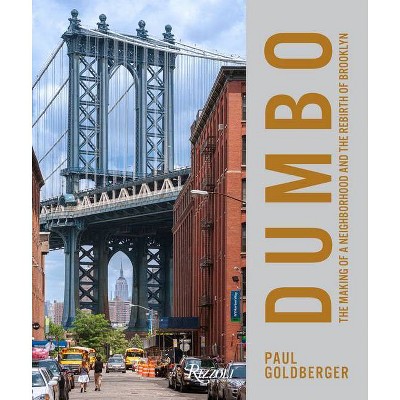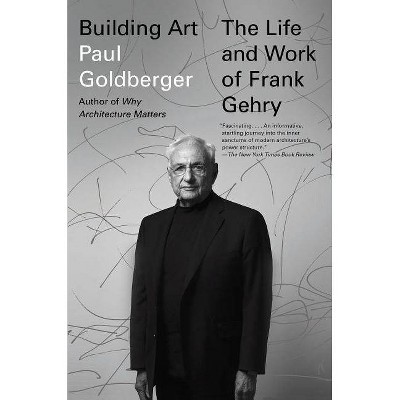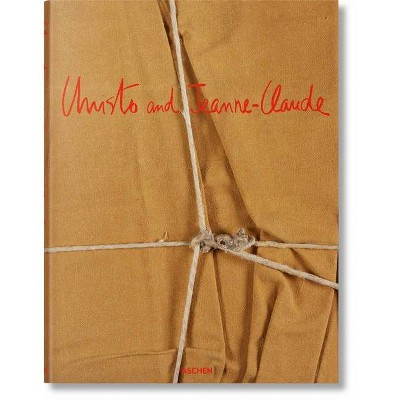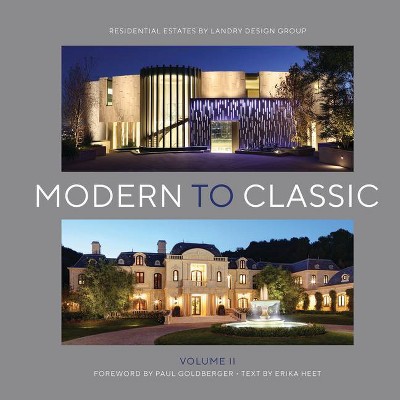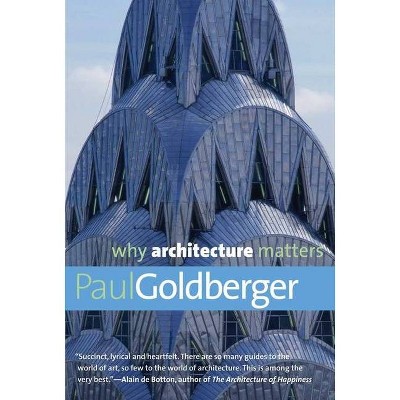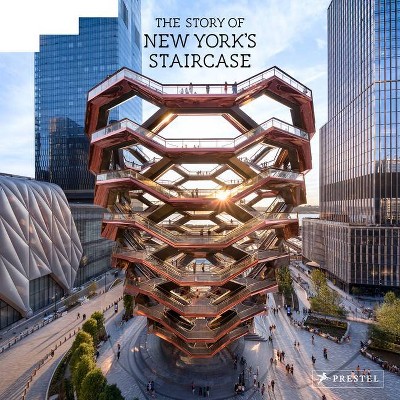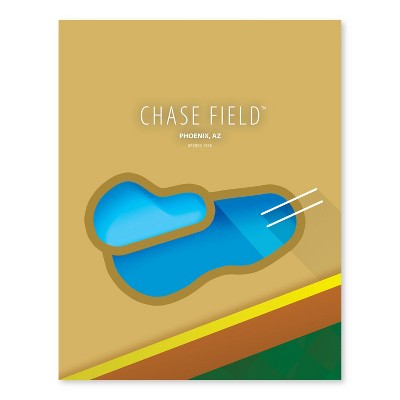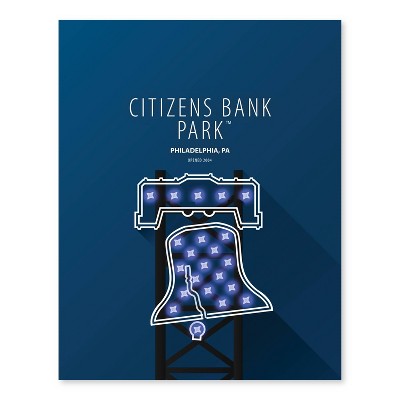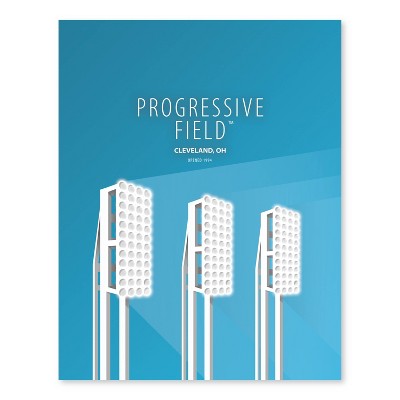Ballpark - by Paul Goldberger (Hardcover)
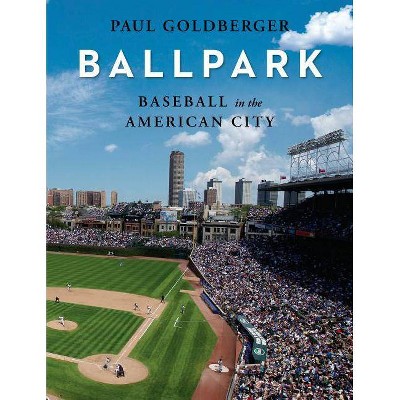
Similar Products
Products of same category from the store
AllProduct info
<p/><br></br><p><b> About the Book </b></p></br></br>"An exhilarating, splendidly illustrated, entirely new look at the history of baseball: told through the stories of the vibrant and ever-changing ballparks where the game was and is staged, by the Pulitzer Prize-winning architectural critic. From the earliest corrals of the mid-1800s (Union Grounds in Brooklyn was a "saloon in the open air"), to the much mourned parks of the early 1900s (Detroit's Tiger Stadium, Cincinnati's Palace of the Fans), to the stadiums we fill today, Paul Goldberger makes clear the inextricable bond between the American city and America's favorite pastime. In the changing locations and architecture of our ballparks, Goldberger reveals the manifestations of a changing society: the earliest ballparks evoked the Victorian age in their accommodations--bleachers for the riffraff, grandstands for the middle-class; the "concrete donuts" of the 1950s and 60s made plain television's grip on the public's attention; and more recent ballparks, like Baltimore's Camden Yards, signal a new way forward for stadium design and for baseball's role in urban development. Throughout, Goldberger shows us the way in which baseball's history is concurrent with our cultural history: the rise of urban parks and public transportation; the development of new building materials and engineering and design skills. And how the site details and the requirements of the game--the diamond, the outfields, the walls, the grandstands--shaped our most beloved ballparks. A fascinating, exuberant ode to the Edens at the heart of our cities--where dreams are as limitless as the outfields"--<p/><br></br><p><b> Book Synopsis </b></p></br></br><b>An exhilarating, splendidly illustrated, entirely new look at the history of baseball: told through the stories of the vibrant and ever-changing ballparks where the game was and is staged, by the Pulitzer Prize-winning architectural critic.</b> <p/>From the earliest corrals of the mid-1800s (Union Grounds in Brooklyn was a saloon in the open air), to the much mourned parks of the early 1900s (Detroit's Tiger Stadium, Cincinnati's Palace of the Fans), to the stadiums we fill today, Paul Goldberger makes clear the inextricable bond between the American city and America's favorite pastime. In the changing locations and architecture of our ballparks, Goldberger reveals the manifestations of a changing society: the earliest ballparks evoked the Victorian age in their accommodations--bleachers for the riffraff, grandstands for the middle-class; the concrete donuts of the 1950s and '60s made plain television's grip on the public's attention; and more recent ballparks, like Baltimore's Camden Yards, signal a new way forward for stadium design and for baseball's role in urban development. Throughout, Goldberger shows us the way in which baseball's history is concurrent with our cultural history: the rise of urban parks and public transportation; the development of new building materials and engineering and design skills. And how the site details and the requirements of the game--the diamond, the outfields, the walls, the grandstands--shaped our most beloved ballparks. <p/>A fascinating, exuberant ode to the Edens at the heart of our cities--where dreams are as limitless as the outfields.<p/><br></br><p><b> Review Quotes </b></p></br></br><br>"I read this entire book! Baseball inspires a religious devotion for me and its many followers. This book by Paul Goldberger gives incredible new insights into the cathedrals at which we love to worship it. I am so grateful for it. Thank you, Paul." <b>--Jerry Seinfeld</b> <p/>As a Pulitzer Prize-winning architecture critic, Paul Goldberger brings scholarship and a discerning eye to these pages. He also brings a thoughtful fan's appreciation of baseball's unique appeal and romance. Qualities which are enhanced, or diminished, by ballpark design. <b>--Bob Costas</b> <p/>"Offers a concise history of major-league ballparks, from the earliest wooden structures to the present . . . Flip to the sections on your favorite parks and you'll find surprising tidbits on nearly every page, [but] the book also mounts a sustained argument across its pages, which makes reading it end to end equally rewarding . . . Lushly illustrated." <b>--John Swansburg, </b><i><b>The New York Times Book Review</b></i> <p/>"Both a beautifully illustrated history of North American baseball stadiums and a defense of the simple but enduring idea of a ballpark that fits neatly into the hum and hive of a grid of city streets . . . Goldberger has an easy way with his descriptions, and his analyses of various ballparks are done with clarity and wit. The book is studded with insightful observations." --<b>Michael Lindgren, <i>The Washington Post</i></b> <p/>There has never been a book on a sports subject that approaches a subject through the historical designs of its playing fields or, surely, does it as well. Through his architectural expertise and with compelling writing skills, Paul Goldberger in <i>Ballpark: Baseball in the American City</i> takes the reader into arenas that embrace unique and pleasurable insights of what is commonly referred to as our national pastime. <b>--Ira Berkow</b> <p/>"[An] entertaining, insightful account of the places that house the national pastime . . . One of the most engaging books to be written on either cities or baseball in the past decade . . . The emotional resonance of <i>Ballpark</i> is a testament to Goldberger's thoughtfulness." <b>--Josh Stephens, <i>Planetizen</i></b> <p/> "Excellent . . . thought-provoking . . . [with] sumptuous photos and illustrations." <b>--Whitney Terrell, <i>Literary Hub</i></b> <p/>"Highly informed and interesting . . . An invaluable book, with delicious stories and insights into both baseball and urban studies. <b>--Richard Horwich, <i>The East Hampton Star</i></b> <p/>"For all of the writing about baseball, no one before has accomplished what the brilliant architecture critic Paul Goldberger does in <i>Ballpark</i>. In illuminating detail, he shows how the places where the game is played say as much about the sport and the changing American aesthetic as wins and losses and managers and owners and players." <b>--David Maraniss, Pulitzer prize-winning author of <i>Clemente: The Passion and Grace of Baseball's Last Hero</i></b> <p/>"A well-illustrated and eminently readable history of this uniquely American structure . . . Enthusiasts of baseball, architecture, and urban history will all relish this fine book." <b>--Andrew Shea, <i>The New Criterion<br></i></b><br>"An engrossing read . . . A work of architectural history and criticism [that] can also be read as a history of baseball or of America and its cities." --<b>Martin Pengelly, <i>The Guardian</i></b> <p/>"Cheerfully approachable . . . [A] scorecard, you might say, of the stadiums, a record of their hits and errors . . . Many of the old ballparks receive their due here . . . [Goldberger] clearly loves the game. But the ballpark, he says, also reflects America's history and culture, its demographic patterns." <b>--David M. Shribman, <i>The Wall Street Journal</i></b> <p/>"An in-depth peek into the history of the stadiums that we have come to know and love. From the first park to the modern stadiums that we enjoy now, Paul Goldberger does and amazing job of collecting and organizing the history of these stadiums in a beautiful way." <b><i><b>--</b></i><b>Danielle McManus, </b><i><b><i>San Francisco Book Review</i></b></i></b> <p/>"Unlike any book ever written, <i>Ballpark </i>captures the romance, the history, the architectural wonder, the neighborhoods, and the pure, unadulterated love of baseball that make up America's major league baseball stadiums, both past and present."<b> --Jerry Milani, <i>NY Sports Day</i></b> <p/>"A fascinating read for baseball fans, architecture enthusiasts, and anyone with a taste for American history (or hot dogs)." <b>--<i>Town & Country</i></b> <p/>"Goldberger draws an irrefutable link between the evolution of baseball park design and America's shifting attitudes towards architecture and urbanism [and] expertly traces the architectural history of the American ballpark and its relationship to the pastoral imagination . . . With <i>Ballpark, </i>Goldberger succeeds in assuring its reader that the building type is as worthy of design scholarship as any other." <b>--Shane Reiner-Roth, <i>Archinect</i></b> <p/>"The still evolving story of the park in the city is one that Paul Goldberger tells brilliantly in <i>Ballpark</i>, a book about architecture and engineering and history, certainly, but profoundly about the soul of the game and our imperiled sense of community." <b>--John Thorn, Official Historian, Major League Baseball</b> <p/>If you love <i>anything</i> about baseball, architecture or the history of modern American cities--just pick one of the three!--you will love <i>Ballpark. </i>Paul Goldberger's passion for how architecture is an integral part of our everyday lives, along with his elegant writing, makes this book an enchanting tour through time and space, and urban aspirations. I doubt I will ever again sit in a ballpark, or any stadium, without thinking of this book. --<b>Douglas Alden</b><i>, </i><b>sports historian and author of ESPN's The Diary of Myles Thomas<br></b><br>"A deep-dive that explores how, with the 'tension between the natural and the man-made, ' the game's stadiums evoke the American city and reflect our relationship to our urban setting . . . Goldberger surveys a litany of parks . . . [<i>Ballpark</i>] effects renewed appreciation for an institution that, year after year, commands our rapt attention." <b>--Stephen Ostrowski, <i>Modern Luxury</i></b> <p/>"An excellent book . . . Very well written and amply illustrated . . . I recommend the book very highly for any baseball fan." --<b>Richard Weigel, <i>Bowling Green Daily News</i></b> <p/> "Goldberger's approach is fresh and intelligent . . . Readers should expect to dig into <i>Ballpark</i> ready to think." --<b>Jerry Milani, <i>Sports Media Report</i></b> <p/>"Watching how Dodger Stadium and Angel Stadium have evolved through these times makes far more sense, thanks to Goldberger's set of intellectual blueprints." <b>--Tom Hoffarth, <i>Farther Off the Wall</i></b> <p/>"Attractive . . . Probing . . . Goldberger recognizes the baseball park's singular power to harmonize the nostalgic rural symbolism of green outfields with the urban dynamism of the surrounding modern city . . . For him, Boston's reverence-inspiring park--together with Brooklyn's Ebbets Field and Chicago's Wrigley Field--will forever define a golden era in the construction of American ballparks. But that shines as just one luminous chapter is this amply illustrated history, stretching from the nineteenth-century Union Grounds, on what had been a Brooklyn skating pond, to twenty-first century Oakland Ballpark, with plans for a landscaped roof when completed in 2023." <b>--Bryce Christensen, <i>Booklist</i> (starred review)</b> <p/>"A tour de force that will appeal to devoted baseball fans, architecture devotees, and even casual readers . . . [Goldberger] discusses the evolving designs in terms of the quality of the viewing experience for fans, and he evaluates how each stadium shapes the city around it--and is simultaneously shaped by the characteristics of that particular city . . .The detail of the research, both its breadth and depth, is remarkable. . . . Includes more than 150 illuminating photos scattered throughout the text." <b>--<i>Kirkus Reviews</i> (starred review)</b><br><p/><br></br><p><b> About the Author </b></p></br></br>PAUL GOLDBERGER, a contributing editor at <i>Vanity Fair, </i> began his career at <i>The New York Times, </i> where he was awarded the Pulitzer Prize for distinguished criticism for his writing on architecture. Later, and for fifteen years, he was architecture critic for <i>The New Yorker.</i> He is the author of many books, most recently <i>Building Art: The Life and Work of Frank Gehry</i> and <i>Why Architecture Matters</i>. He teaches at the New School and lectures widely around the country on architecture, design, historic preservation, and cities. He and his wife live in New York City.
Price History
Cheapest price in the interval: 17.69 on November 8, 2021
Most expensive price in the interval: 17.69 on December 20, 2021
Price Archive shows prices from various stores, lets you see history and find the cheapest. There is no actual sale on the website. For all support, inquiry and suggestion messages communication@pricearchive.us
